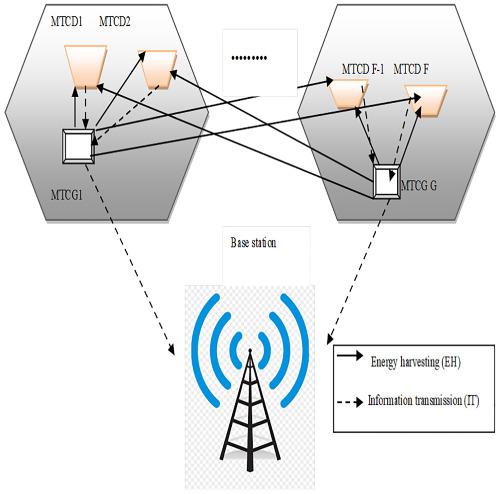当前位置:
X-MOL 学术
›
Int. J. Commun. Syst.
›
论文详情
Our official English website, www.x-mol.net, welcomes your feedback! (Note: you will need to create a separate account there.)
Optimal Resource allocation in NOMA‐based M2M communication using Hybrid Rider Optimization with FireFly: Power Saving Strategy of IoT
International Journal of Communication Systems ( IF 2.1 ) Pub Date : 2020-06-10 , DOI: 10.1002/dac.4462 Selvam K 1 , Kumar K 1
International Journal of Communication Systems ( IF 2.1 ) Pub Date : 2020-06-10 , DOI: 10.1002/dac.4462 Selvam K 1 , Kumar K 1
Affiliation

|
Nowadays, the Orthogonal Multiple Access (OMA) principle has utilized for allocating proper radio resources in wireless networks. However, as the count of users rises, OMA‐based approaches may not satisfy the stringent emerging requirements including very low latency, very high spectral efficiency, and massive device connectivity. Moreover, there are significant challenges in cellular‐enabled Machine‐to‐Machine (M2M) communications due to the unique features of M2M‐based applications. In order to overwhelm these challenges, non‐orthogonal multiple access (NOMA) principles emerge as a solution to enhance the spectral efficiency while allowing some degree of multiple access interference at receivers. Hence, this paper intends to develop an optimal resource allocation mechanism for M2M communication. Here, the nonlinear energy harvesting performed with the aid of an accessing technology termed as NOMA. The key objective of the proposed resource allocation model is the minimization of the total energy consumption of the network. For attaining the minimized power consumption, the time allocation, and transmission power of NOMA is optimally tuned by a hybrid optimization algorithm. The proposed hybrid algorithm merges the beneficial concepts of Rider Optimization Algorithm (ROA) and FireFly (FF) algorithm and implements a new algorithm termed as FireFly Modified Bypass‐based Rider Optimization Algorithm (FMB‐ROA). Finally, the analysis of total energy concerning various constraints validates the performance of the proposed model over conventional models.
中文翻译:

使用带有FireFly的混合骑手优化功能的基于NOMA的M2M通信中的最佳资源分配:物联网的节能策略
如今,正交多路访问(OMA)原理已用于在无线网络中分配适当的无线电资源。但是,随着用户数量的增加,基于OMA的方法可能无法满足严格的新兴要求,包括极低的延迟,极高的频谱效率以及庞大的设备连接性。此外,由于基于M2M的应用程序的独特功能,因此在具有蜂窝功能的机器对机器(M2M)通信中也面临着巨大的挑战。为了克服这些挑战,非正交多址接入(NOMA)原则应运而生,可以提高频谱效率,同时在接收器上允许一定程度的多址干扰。因此,本文旨在为M2M通信开发一种最优的资源分配机制。这里,借助称为NOMA的访问技术执行的非线性能量收集。提出的资源分配模型的主要目标是最小化网络的总能耗。为了获得最小的功耗,通过混合优化算法对NOMA的时间分配和传输功率进行了优化。提出的混合算法融合了车手优化算法(ROA)和FireFly(FF)算法的有益概念,并实现了一种称为FireFly改进的基于旁路的车手优化算法(FMB-ROA)的新算法。最后,关于各种约束的总能量分析验证了所提出的模型优于常规模型的性能。提出的资源分配模型的主要目标是最小化网络的总能耗。为了获得最小的功耗,通过混合优化算法对NOMA的时间分配和传输功率进行了优化。提出的混合算法融合了车手优化算法(ROA)和FireFly(FF)算法的有益概念,并实现了一种称为FireFly改进的基于旁路的车手优化算法(FMB-ROA)的新算法。最后,关于各种约束的总能量分析验证了所提出的模型优于常规模型的性能。提出的资源分配模型的主要目标是最小化网络的总能耗。为了获得最小的功耗,通过混合优化算法对NOMA的时间分配和传输功率进行了优化。提出的混合算法融合了车手优化算法(ROA)和FireFly(FF)算法的有益概念,并实现了一种称为FireFly改进的基于旁路的车手优化算法(FMB-ROA)的新算法。最后,关于各种约束的总能量分析验证了所提出的模型优于常规模型的性能。利用混合优化算法对NOMA的发射功率进行了优化。提出的混合算法融合了车手优化算法(ROA)和FireFly(FF)算法的有益概念,并实现了一种称为FireFly改进的基于旁路的车手优化算法(FMB-ROA)的新算法。最后,关于各种约束的总能量分析验证了所提出的模型优于常规模型的性能。利用混合优化算法对NOMA的发射功率进行了优化。提出的混合算法融合了车手优化算法(ROA)和FireFly(FF)算法的有益概念,并实现了一种称为FireFly改进的基于旁路的车手优化算法(FMB-ROA)的新算法。最后,关于各种约束的总能量分析验证了所提出的模型优于常规模型的性能。
更新日期:2020-06-10
中文翻译:

使用带有FireFly的混合骑手优化功能的基于NOMA的M2M通信中的最佳资源分配:物联网的节能策略
如今,正交多路访问(OMA)原理已用于在无线网络中分配适当的无线电资源。但是,随着用户数量的增加,基于OMA的方法可能无法满足严格的新兴要求,包括极低的延迟,极高的频谱效率以及庞大的设备连接性。此外,由于基于M2M的应用程序的独特功能,因此在具有蜂窝功能的机器对机器(M2M)通信中也面临着巨大的挑战。为了克服这些挑战,非正交多址接入(NOMA)原则应运而生,可以提高频谱效率,同时在接收器上允许一定程度的多址干扰。因此,本文旨在为M2M通信开发一种最优的资源分配机制。这里,借助称为NOMA的访问技术执行的非线性能量收集。提出的资源分配模型的主要目标是最小化网络的总能耗。为了获得最小的功耗,通过混合优化算法对NOMA的时间分配和传输功率进行了优化。提出的混合算法融合了车手优化算法(ROA)和FireFly(FF)算法的有益概念,并实现了一种称为FireFly改进的基于旁路的车手优化算法(FMB-ROA)的新算法。最后,关于各种约束的总能量分析验证了所提出的模型优于常规模型的性能。提出的资源分配模型的主要目标是最小化网络的总能耗。为了获得最小的功耗,通过混合优化算法对NOMA的时间分配和传输功率进行了优化。提出的混合算法融合了车手优化算法(ROA)和FireFly(FF)算法的有益概念,并实现了一种称为FireFly改进的基于旁路的车手优化算法(FMB-ROA)的新算法。最后,关于各种约束的总能量分析验证了所提出的模型优于常规模型的性能。提出的资源分配模型的主要目标是最小化网络的总能耗。为了获得最小的功耗,通过混合优化算法对NOMA的时间分配和传输功率进行了优化。提出的混合算法融合了车手优化算法(ROA)和FireFly(FF)算法的有益概念,并实现了一种称为FireFly改进的基于旁路的车手优化算法(FMB-ROA)的新算法。最后,关于各种约束的总能量分析验证了所提出的模型优于常规模型的性能。利用混合优化算法对NOMA的发射功率进行了优化。提出的混合算法融合了车手优化算法(ROA)和FireFly(FF)算法的有益概念,并实现了一种称为FireFly改进的基于旁路的车手优化算法(FMB-ROA)的新算法。最后,关于各种约束的总能量分析验证了所提出的模型优于常规模型的性能。利用混合优化算法对NOMA的发射功率进行了优化。提出的混合算法融合了车手优化算法(ROA)和FireFly(FF)算法的有益概念,并实现了一种称为FireFly改进的基于旁路的车手优化算法(FMB-ROA)的新算法。最后,关于各种约束的总能量分析验证了所提出的模型优于常规模型的性能。



























 京公网安备 11010802027423号
京公网安备 11010802027423号